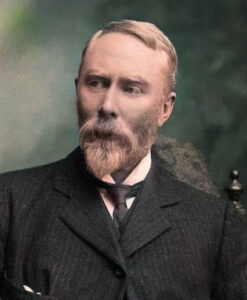1920: Cook Strait Sky Captain
August 25, 2023
By AHNZ
 Today in New Zealand history, 25 August, 1920, South Islanders made history over 7 hours by flying from Christchurch to Trentham. This trip of the Canterbury Aviation Company’s Le Rhone Avro aircraft carried 3 warmly-clothed men in an open cockpit. Pilot Euan Dickson had the company engineer as well as the company’s Deputy Director with him and lots of publicity mail addressed to politicians and press. This day was also one of the first times, if not the first ever, that anyone had seen Wellington from from Kaikoura.
Today in New Zealand history, 25 August, 1920, South Islanders made history over 7 hours by flying from Christchurch to Trentham. This trip of the Canterbury Aviation Company’s Le Rhone Avro aircraft carried 3 warmly-clothed men in an open cockpit. Pilot Euan Dickson had the company engineer as well as the company’s Deputy Director with him and lots of publicity mail addressed to politicians and press. This day was also one of the first times, if not the first ever, that anyone had seen Wellington from from Kaikoura.
What was the most striking feature of the journey? “I should think,” replied Dickson, “it was seeing- Wellington from Kaikoura so distinctly. The Kaikouras, of course, were the outstanding feature of the trip, but we got few bumps over them..” Ref. Evening Post (1920,) Papers Past
Leo and Vivian Walsh had been pioneering powered flight for a decade and were just about to cross Cook Strait themselves the very next day! After the successful return flight Captain Dickson remarked that it especially appealed to him “that a victory had been won by the South Island which could not be taken away.”¹ Ref. 1911: Powered Flight, AHNZ
The pioneers also remembered their Chief Flying Instructor Cecil Hill who had been recruited from London but killed after a mid-air failure aged just 34 on 1 February, 1919. Along with training, the enthusiastic Canterbury Aviation Company had constructed its own aircraft as a response to their first, imported one, being unfit. This, the White Wings, flew successfully in July 1917 and others were to follow. Ref. New Zealand’s Heritage (1971)
Henry Wigram was the main man behind this Aviation Company. After success in business, the Mayoralty of Christchurch, and retirement from the Legislative Council, what came next in life for a man born in 1857? Not retirement, but advancing the cause of South Island aviation based out of Sockburn in Christchurch. After the Cook Strait flight he spoke to remember Chief Cecil Hill and the sitting Mayor Doctor Henry Thacker suggested a marble pillar memorial at the intersection of Sockburn and Yaldhurst roads. This apparently didn’t happen but Mayor’s talk is cheap.
“The Flying Training School at Sockburn, operated by the Canterbury Aviation Company, was formed in 1917. Like the Walshs, the company had applied to the New Zealand Government for assistance and had been refused, and, like them, it had entered into an agreement with the British Government.” – Royal New Zealand Air Force, Ross (1955,) NZETC
“It hoped to win government support for the establishment of commercial services and secure itself a regular income… in January 1921, the government’s Air Board directed the Canterbury Aviation Company to begin an airmail service from Christchurch to Ashburton and Timaru. This failed to attract the custom it needed to make a profit and the Air Board closed it down three months later. The company continued to struggle and in 1923 the government purchased its land and assets as the base for the newly formed Permanent Air Force.” – nzhistory.govt.nz
“Sir donated £10,000 towards the Government’s purchase of Sockburn airfield and a further £2,500 towards the N.Z.P.A.F.’s first new aircraft…in 1927 the first new recruits were accepted, the nucleus of the Royal New Zealand Air Force.” – p2214, NZH (1971)
“But the men who battled for success in the first years of aviation also deserve great credit. If their many trials- and equally numerous errors- seemed to achieve little, it was through their efforts that others found the way.” – p2018, NZH (1971)
 Aviation, like all other innovations and good things, was a result of free people’s initiative. The Government simply came along after the fact and claimed it so that Wigram’s Canterbury Aviation Company became the Royal New Zealand Air Force. An air force is a good thing for New Zealand and Wigram saw this as early as 1908 and acted to get one for his country. In particular, he acted to make Christchurch the main base and the parochial South Island loyalty of his generation was evident in 1920 coming from his pilot when he called the crossing “victory for the South Island.”
Aviation, like all other innovations and good things, was a result of free people’s initiative. The Government simply came along after the fact and claimed it so that Wigram’s Canterbury Aviation Company became the Royal New Zealand Air Force. An air force is a good thing for New Zealand and Wigram saw this as early as 1908 and acted to get one for his country. In particular, he acted to make Christchurch the main base and the parochial South Island loyalty of his generation was evident in 1920 coming from his pilot when he called the crossing “victory for the South Island.”
On the one hand it seems that Wigram was a great patriot. Yet we must be suspicious of a Christchurch Mayor (1902–1904.) And a Legislative Council Member. And, the Mayor who gobbled up for the Christchurch Megacity the amalgams of previously independent Linwood, St Albans and Sydenham.
Henry gifted the Aviation Club to the State in 1923 but as part of the deal put in £10,000 of his own money so it could buy Sockburn Airfield. It was re-named ‘Wigram’ for him and Henry was knighted in 1926 at about the same time. He also put in £2,500 so the RNZAF (then called NZPAF: New Zealand Permanent Air Force est.1923) could get off the ground with its first 3 fighter planes. What’s going on here?
It’s curious that a man like Wigram wasn’t able to pull off the enterprise of starting up a successful airmail service. The Government’s Air Board did not reward the Cook Strait demonstration with that patronage nor stick with the Cantabrians. It’s also curious that he should hand over the land and assets of the free club to The State and apparently not see a return. Indeed, to also be paying The State £12,500 to take it off our hands!? In 1932 he “gifted” even more land so Wigram Airbase could expand; Surely he got some quid pro quo? Something else is surely going on here. That’s a high price to pay for a title and an airbase, even if it was the airbase, being named after you.
Unfortunately the Wigram Airbase is no more. The RNZAF abandoned their Christchurch base on 1 March 2009 and much of the essential airdrome was given to Ngai Tahu Maori tribesmen in the early days of the National 5.0 Ministry. However, it is at least still home to the Air Force Museum of New Zealand.
—
1 Ref. Sun (1920,) Papers Past
Image ref. Henry Wigram in 1903, Alexander Turnbull Library. AHNZ colour and mod
 Like Comment Share
Like Comment Share





